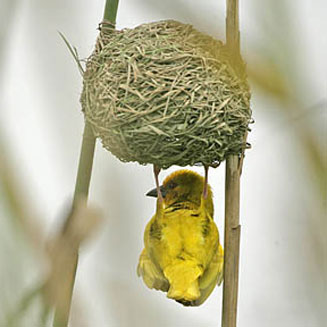|
Ploceus subaureus (Yellow
weaver)
Geelwewer [Afrikaans]; Intletlekwane [Xhosa]; Goudwever [Dutch];
Tisserin jaune [French]; Kleiner goldweber [German]; Tecel„o-amarelo
[Portuguese]
Life
> Eukaryotes >
Opisthokonta
> Metazoa (animals) >
Bilateria >
Deuterostomia > Chordata >
Craniata > Vertebrata (vertebrates) > Gnathostomata (jawed
vertebrates) > Teleostomi (teleost fish) > Osteichthyes (bony fish) > Class:
Sarcopterygii (lobe-finned
fish) > Stegocephalia (terrestrial
vertebrates) > Tetrapoda
(four-legged vertebrates) > Reptiliomorpha > Amniota >
Reptilia (reptiles) >
Romeriida > Diapsida > Archosauromorpha > Archosauria >
Dinosauria
(dinosaurs) > Saurischia > Theropoda (bipedal predatory dinosaurs) >
Coelurosauria > Maniraptora > Aves
(birds) >
Order: Passeriformes > Family: Ploceidae
> Genus: Ploceus
Distribution and habitat
Occurs from Kenya through Tanzania to Malawi and
Mozambique, extending down the east coast to KwaZulu-Natal and the Eastern Cape.
It generally prefers river flood plains, coastal plains, estuaries and lowland
river valleys, but it is mainly restricted to reedbeds and adjacent riverine
vegetation while breeding.
|
 |
|
Distribution of Yellow weaver in southern Africa,
based on statistical smoothing of the records from first SA Bird Atlas
Project (©
Animal Demography unit, University of
Cape Town; smoothing by Birgit Erni and Francesca Little). Colours range
from dark blue (most common) through to yellow (least common).
See here for the latest distribution
from the SABAP2. |
Brood parasites
It has been recorded as host of the
Diderick
cuckoo.
Food
It mainly eats seeds, insects and nectar, foraging on the
ground and in vegetation, occasionally hawking termite alates aerially. The following food items have been recorded
in its diet:
- Plants
- seeds
- flower anthers of Nicotania glauca (Wild tobacco)
- nectar
- Erythrina caffra (Coast coral-tree)
- Aloe barberae (Eastern tree aloe)
- Insects
Breeding
- Probably polygynous colonial nester, with about 10-20, rarely 50 nests per
colony, sometimes breeding alongside Southern brown-throated (Ploceus xanthopterus)
and Thick-billed weavers (Amblyospiza
albifrons).
- Each male builds multiple circular nests (see image below) which lack an
entrance tunnel, woven from grass stems and lined by the female with softer
grass. It is typically attached to one, sometimes two reed stems about 1-2
meters above water, although it may occasionally use trees instead.
 |
|
|
Yellow weaver at its nest, Kidd's Beach, South
Africa. [photo Warwick Tarboton ©] |
|
- Egg-laying season is from about September-February, peaking from
September-December.
- It lays 2-4 eggs, which are incubated solely by the female.
- The chicks are fed on a diet of mainly insects, leaving the nest after
about 19-22 days.
Threats
Not threatened.
References
-
Hockey PAR, Dean WRJ and Ryan PG 2005. Roberts
- Birds of southern Africa, VIIth ed. The Trustees of the John Voelcker
Bird Book Fund, Cape Town.
|
